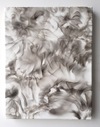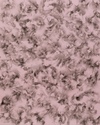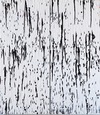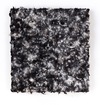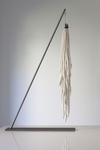Matthew Satz
Matthew Satz (b.1971 Brooklyn, New York)
Concept + Process = Aesthetic
A cryptic shorthand note appears in an early sketchbook of Matt Satz’. Beneath a handwritten list of artists — Jasper Johns, Robert Rauschenberg, Sigmar Polke and Sol Lewitt — Satz has scrawled, “Kill your Fathers – Mythological/Historical ref.,” “Patricide,” and “Titans vs. Gods.”
It’s an oblique aside to an Oedipal struggle that informs his work – a struggle that cuts to the heart of Satz’s paradoxical relationship to painting. He’s a painter committed to the end of painting. Cast in this formula, it’s a bold, perhaps useless project, one suited to the temperament of last century’s art. A closer look, however, reveals a hidden subtlety: there is an ambivalence to the meaning of “end” that is often lost in English but captured perfectly by the Greek word, telos. And since Satz invokes the Greek’s famous battle between immortals, a comment about this ambivalence is not out of place here.
Telos is commonly translated in English as “end.” Like the English word, it can signify a terminal state. The Greeks, however, were more concerned with a meaning of “end” that our own language, except in rare instances, has buried. For them, an end was a goal, something to be aimed at, and an existential imperative to be fulfilled, however difficult. Ends were not the termination of things or events, rather their complete realization. For instance, in the Greek world the end of human life was not its biological death but a state of being virtuous. Humans, having achieved their ends, had not ended their lives, they had realized their common essence.
Satz’s notebook commentary displays his awareness of, and struggle with, these shades of meaning. On the one hand, he is aware of the numerous attempts to end painting: Duchamp, an artist involved in one of the most unique End Game art strategies of the last century, recurs. So too, the gambits of Malevich, Rodchenko, Reinhardt and Stella are present on the pages. Satz, an artist steeped in the provocations of his artistic forebears, is aware that entire movements of post-war art, from minimalism to conceptualism, have demanded painting’s death, citing its elitism, obsolescence, commodity status and irrelevance. Though temporarily out of favor, painting outlived them all. Invariably, it continued hidden from the mainstream, out of view of the latest isms to dominate the galleries and art magazines. Usually, it re-emerged with a vengeance and flourished, as it did in the early eighties.
Satz refuses to be intimidated by the scorn he courts by throwing himself into one of last century’s titanic dramas, the struggle for the life and death of painting. He refuses to heed the direction of fashion’s wind and thereby joins a long line of fools, holy goofs, and saints who fearlessly rushed, faced critical outrage, and occasionally plummeted to their deaths. In this age of modest art, and even less ambitious goals, is Satz crazy to tilt at windmills and revivify the age-old battle between Titans and Gods? The answer is in his self-conscious art.
In 1997, Satz drew the image of a target. For years it lay hidden in a notebook and buried in his consciousness. In 1999 he began a series of tar and feather paintings. They were what they advertised: abstract paintings made entirely of tar and feathers.
He liked the fit between the idea embodied in the practice of tarring and feathering and the process of tarring and feathering the canvas. It was another way of responding to painting’s power over him. In 2004, the target of his notebook re-emerged and Satz painted a tar and feather target on a gallery wall as part of a larger exhibition of his work. With that act he took aim at his father figure, Jasper Johns. It was another provocation, a way for Satz to enter into competition and add to the vocabulary of painting’s patricide.
Another Greek word comes to mind: hubris. It amounts to comparing oneself to the gods, and for the Greeks it is the vice at the root of most heroic downfalls. Arachne, Laius, Naobe, Jason, and Oedipus were all punished for this lack of humility. In their pride these mortals displayed an unwillingness to respect, or even acknowledge a hierarchy of vested interests, and a ruling elite that decided what was and was not acceptable for the mere mortal. Authority in the Greek world was to be acknowledged and maintained at all costs. Stepping beyond one’s place, refusing to follow the established order, the logos, doomed one to unbearable suffering.
In twenty-first century America the rules may be looser, the track to success faster, but one must be sensitive to the underlying order, however hidden from view, in order to avoid the fall — which is just as fast, painful, and witnessed with malicious relish as it was in ancient Greece. The art world is just as deadly. It comes with its own regime of authority, one that has insinuated itself in museums, galleries and magazines. It’s an army of loyal curators, critics, gallerists and collectors.
Satz’s art amounts to a disloyal questioning of that army. It places itself squarely in an insurgency by resurrecting a portion of the ideas of Clement Greenberg. Of all that is taboo in today’s art, none is more so than the theories of Greenberg, the critic who autocratically ruled the art world for most of the post-war period. He favored art-heroes forged in the crucible of the crisis in art, and who struggled with complex issues of form and content. He claimed painting had meaning only insofar as it uncovered essences and displayed the process of creation. He was the victim of patricide in the early seventies when his students turned against him and shot their sheriff.
Fearful of his reach beyond the grave, the art world has stood vigilant against his return. Their single eye, aloft in a blasted academic tower, has searched restlessly for signs of his formalist ghost. As fallout, the art world has grown allergic to artistic immodesty, the attempt to uncover painting’s essence, or to push it beyond itself into new realms of aesthetic possibility. From the perspective of the contemporary art world, Satz’s work contains echoes of that immodesty.
In a country that prides itself on its modesty but acts with an international swagger bigger than its stick, it’s time to dispense with hypocrisy and embrace these abused heroic ambitions. It’s time to create an art that reaches to the gods and courts critical antipathy. It’s time to challenge the after-effects of formalism’s reign, humble projects, and diminutive ideas, which overtook the art world after Pop.
Satz’s art speaks to this ambition. Surprisingly it is executed in a modest fashion – in a style combining an intellectual engagement with art’s history and the sensuality of paint. The formula for this engagement is a constant theme in Satz’s notebooks; it acts as a leitmotif of his art: concept plus process equals aesthetic. In essence, Satz’s art is the realization of an idea in an appropriate process. The end result, the painting, is part idea, part process. The most visible element of that work — what Duchamp called painting’s retinal quality and what Satz terms “the aesthetic,”— is the least important part of the equation.
Satz, however, too keenly appreciates painting’s sensual qualities, despite what he claims, to kill the aesthetic. And traditional painting – paint applied to a canvas support – is too resilient to die. Though he returns to the scene of the crime to savor his handiwork in progressively refined artworks, achieving his goal of combining idea with process to derive the aesthetic, Satz finds himself staring at paintings both conceptually rigorous and optically stimulating.
But the need to negate the aesthetic is a powerful engine driving Satz. It’s especially visible in two related bodies of work, the Strip paintings and the Strip-Edge paintings. The Strip paintings began as a challenge to add to the vocabulary of painters who poured, dripped and striped. The work abounds in witty asides to Pollock, Bridget Riley, and even Gene Davis (an artist Satz was unaware of when making the paintings). In a further art historical reference, the body of paintings alludes to another notorious aesthetic symbol, Barnett Newman’s zip. Perhaps coincidentally, both “stripe” and “drip” contain the diminutive element, r.i.p..
But Satz did not begin these paintings to play merely on teasing allusions, nor was he suggesting his own artistic striptease. Rather, Satz chose to make these works out of a desire to challenge the painters who made careers out of the line. To add to his contribution, Satz determined to make his line by eliminating his hand in the manipulation of paint. Dueling Morris Louis, he poured paint down the painting’s face, letting gravity collaborate in the line’s direction, while manipulating the ground of the painting to alter the line’s movement on its surface. The innovation is subtle, but important, and its evidence is sometimes found in the remains of fingerprints on the paintings’ sides.
At first these paintings were tight and sleekly minimal, with each poured line touching the preceding one. If a space appeared between the lines, Satz started over. Eventually, repouring caused drips to form at the painting’s bottom edge. The more times Satz had to return to a specific line and repour, the longer the drip. From this essential component of the process a new aspect of Satz’s Strip painting emerged: his Strip painting grew stalactites of pure paint.
The extension of paint beyond the canvas brought the space beneath the painting into sharp relief and led Satz to focus on the canvas’s bottom edge (an area of the painting disparaged by Johns and commented upon by Brice Marden), something he could not possibly have foreseen when he began the paintings. After a short period of time, some of the paintings grew beautifully elongated drips caught in the act of falling off the canvas. It was a magical effect but problematic for Satz: the aesthetic he attempted to banish had returned with a vengeance.
As the Strip paintings loosened up and grew more expressionistic, the aesthetic element grew stronger. Aware of this development, and fearful the audience might lose sight of the conceptual aim of these paintings, Satz began killing the aesthetic off, first by painting monochromatic Strip paintings – which stopped the eye from fixing on the tonal surface qualities of the paintings – then by boxing the paintings. The box acted as a tool to emphasize the space just beneath the bottom edge. Finally, he literally chased the paint off the paintings’ face until only the bottom painted edge and drip remained. For Satz this constituted the new painting: the Strip-Edge painting was born.
Greenberg believed that true artists, loyal to the cause of painting’s autonomy, grew progressively aware of painting’s own intrinsic qualities and problems. They moved closer to those qualities in a dialectical struggle of self-criticism. New work, he argued, should emerge out of a struggle with, and reflection upon, a previous body of art. Satz, though by no means a conscious adherent of this philosophy, has in practice followed its logic. He has also resisted it by being open to chance. In his work accidents emerge from the process and become essential to the movement between groups of paintings. The chain of Satz’s painting follows this interaction of logic and the unpredictable accidence of intuition. Satz began his Smoke paintings, for example, with the idea to create a beautiful line (challenging Twombly and Marden). First he built up the ground on a flat surface; then he suspended the painting above him and let smoke rise to infuse with the paint, creating a seamless surface. This manipulation of the canvas caused Satz to notice excess paint forming crude drips on the painting’s edges. He began to think about the effects of gravity, and that insight led him to continue the challenge of the line in the Strip paintings.
The logical and organic growth continued: strips led to Strip-Edge paintings. After the success of these paintings, Satz chased the paint off the entire surface, eventually detaching the drip. These detached drips led to the Strand pieces – long, narrow strips of rolled linen painted with a drip method. Though sculptural, he referred to these pieces as paintings: for they were elemental reductions of canvas and paint.
Following the natural progression of his methodology and in a self-referential comment on appropriation, Satz began using his paintings to create other works. Employing the strand as a paintbrush, by dripping paint onto the strand and letting it drip onto a painting’s surface below, the By-Product painting emerged. Here the object once identified with a traditional painting, a stretched canvas, was now being painted with Satz’s version of the painting at its elemental level, the Strand. Later, Satz created a new variant: trying to avoid dripping paint on the floor, he put sheets of paper under the works in progress to catch the dripping surplus paint. The result, loose strands of dripped paint, created a new body of By-Product works on paper.
Recently, Satz dripped clearcoat down the canvas surface to eliminate any trace of the aesthetic. He failed – the clearcoat dried to a beautiful golden hue. Undaunted, Satz’s latest work is an object, part painting, part sculpture, made from casting the form of a painting and injecting the mold with clear resin. The result is a translucent object that reveals all the texture and shape of the original. Satz has named this piece, “Painting Sculpture (Tabula Rasa).” Not without irony, the stretcher support creates the penumbra of a Malevich.
This cat and mouse game is the unfolding drama of Satz’s painting. He has followed painting from smoke to ash and from drip to strip. Each time he gets close to achieving his end, painting evades him, pushing him to make a new beginning with a new blank slate. T. S. Eliot, in The Four Quartets, wrote, “In our ends are our beginnings.” Perusing this book the spectator can follow Satz going where the paint takes him. They can witness the many embodiments of his belief that he will catch up to painting and put it out of its misery (or it will take him down kicking and screaming). In painting after painting the results are the same, paintings that end in fulfillment. Each time it ends in a beginning.
It’s part of the pleasure to know that Satz, consciously or not, is contributing to painting’s revival. Aristotle, in his Physics, discusses what happens to organic objects that fulfill their end. When their goal is achieved and the essence realized, it’s the natural order of organic things, Aristotle argues, to reproduce. Satz is so bent on the end of painting that he’s literally taken it to the canvas’s bottom edge to kill the aesthetic. He’s been drawn into that artistic duel, as so many artistic forbears have, and in the attempt he’s brought painting closer to its end, creating paintings that are, in spite of and because of his process, ravishing.
– John McWhinnie (1968 – 2012)
Concept + Process = Aesthetic
A cryptic shorthand note appears in an early sketchbook of Matt Satz’. Beneath a handwritten list of artists — Jasper Johns, Robert Rauschenberg, Sigmar Polke and Sol Lewitt — Satz has scrawled, “Kill your Fathers – Mythological/Historical ref.,” “Patricide,” and “Titans vs. Gods.”
It’s an oblique aside to an Oedipal struggle that informs his work – a struggle that cuts to the heart of Satz’s paradoxical relationship to painting. He’s a painter committed to the end of painting. Cast in this formula, it’s a bold, perhaps useless project, one suited to the temperament of last century’s art. A closer look, however, reveals a hidden subtlety: there is an ambivalence to the meaning of “end” that is often lost in English but captured perfectly by the Greek word, telos. And since Satz invokes the Greek’s famous battle between immortals, a comment about this ambivalence is not out of place here.
Telos is commonly translated in English as “end.” Like the English word, it can signify a terminal state. The Greeks, however, were more concerned with a meaning of “end” that our own language, except in rare instances, has buried. For them, an end was a goal, something to be aimed at, and an existential imperative to be fulfilled, however difficult. Ends were not the termination of things or events, rather their complete realization. For instance, in the Greek world the end of human life was not its biological death but a state of being virtuous. Humans, having achieved their ends, had not ended their lives, they had realized their common essence.
Satz’s notebook commentary displays his awareness of, and struggle with, these shades of meaning. On the one hand, he is aware of the numerous attempts to end painting: Duchamp, an artist involved in one of the most unique End Game art strategies of the last century, recurs. So too, the gambits of Malevich, Rodchenko, Reinhardt and Stella are present on the pages. Satz, an artist steeped in the provocations of his artistic forebears, is aware that entire movements of post-war art, from minimalism to conceptualism, have demanded painting’s death, citing its elitism, obsolescence, commodity status and irrelevance. Though temporarily out of favor, painting outlived them all. Invariably, it continued hidden from the mainstream, out of view of the latest isms to dominate the galleries and art magazines. Usually, it re-emerged with a vengeance and flourished, as it did in the early eighties.
Satz refuses to be intimidated by the scorn he courts by throwing himself into one of last century’s titanic dramas, the struggle for the life and death of painting. He refuses to heed the direction of fashion’s wind and thereby joins a long line of fools, holy goofs, and saints who fearlessly rushed, faced critical outrage, and occasionally plummeted to their deaths. In this age of modest art, and even less ambitious goals, is Satz crazy to tilt at windmills and revivify the age-old battle between Titans and Gods? The answer is in his self-conscious art.
In 1997, Satz drew the image of a target. For years it lay hidden in a notebook and buried in his consciousness. In 1999 he began a series of tar and feather paintings. They were what they advertised: abstract paintings made entirely of tar and feathers.
He liked the fit between the idea embodied in the practice of tarring and feathering and the process of tarring and feathering the canvas. It was another way of responding to painting’s power over him. In 2004, the target of his notebook re-emerged and Satz painted a tar and feather target on a gallery wall as part of a larger exhibition of his work. With that act he took aim at his father figure, Jasper Johns. It was another provocation, a way for Satz to enter into competition and add to the vocabulary of painting’s patricide.
Another Greek word comes to mind: hubris. It amounts to comparing oneself to the gods, and for the Greeks it is the vice at the root of most heroic downfalls. Arachne, Laius, Naobe, Jason, and Oedipus were all punished for this lack of humility. In their pride these mortals displayed an unwillingness to respect, or even acknowledge a hierarchy of vested interests, and a ruling elite that decided what was and was not acceptable for the mere mortal. Authority in the Greek world was to be acknowledged and maintained at all costs. Stepping beyond one’s place, refusing to follow the established order, the logos, doomed one to unbearable suffering.
In twenty-first century America the rules may be looser, the track to success faster, but one must be sensitive to the underlying order, however hidden from view, in order to avoid the fall — which is just as fast, painful, and witnessed with malicious relish as it was in ancient Greece. The art world is just as deadly. It comes with its own regime of authority, one that has insinuated itself in museums, galleries and magazines. It’s an army of loyal curators, critics, gallerists and collectors.
Satz’s art amounts to a disloyal questioning of that army. It places itself squarely in an insurgency by resurrecting a portion of the ideas of Clement Greenberg. Of all that is taboo in today’s art, none is more so than the theories of Greenberg, the critic who autocratically ruled the art world for most of the post-war period. He favored art-heroes forged in the crucible of the crisis in art, and who struggled with complex issues of form and content. He claimed painting had meaning only insofar as it uncovered essences and displayed the process of creation. He was the victim of patricide in the early seventies when his students turned against him and shot their sheriff.
Fearful of his reach beyond the grave, the art world has stood vigilant against his return. Their single eye, aloft in a blasted academic tower, has searched restlessly for signs of his formalist ghost. As fallout, the art world has grown allergic to artistic immodesty, the attempt to uncover painting’s essence, or to push it beyond itself into new realms of aesthetic possibility. From the perspective of the contemporary art world, Satz’s work contains echoes of that immodesty.
In a country that prides itself on its modesty but acts with an international swagger bigger than its stick, it’s time to dispense with hypocrisy and embrace these abused heroic ambitions. It’s time to create an art that reaches to the gods and courts critical antipathy. It’s time to challenge the after-effects of formalism’s reign, humble projects, and diminutive ideas, which overtook the art world after Pop.
Satz’s art speaks to this ambition. Surprisingly it is executed in a modest fashion – in a style combining an intellectual engagement with art’s history and the sensuality of paint. The formula for this engagement is a constant theme in Satz’s notebooks; it acts as a leitmotif of his art: concept plus process equals aesthetic. In essence, Satz’s art is the realization of an idea in an appropriate process. The end result, the painting, is part idea, part process. The most visible element of that work — what Duchamp called painting’s retinal quality and what Satz terms “the aesthetic,”— is the least important part of the equation.
Satz, however, too keenly appreciates painting’s sensual qualities, despite what he claims, to kill the aesthetic. And traditional painting – paint applied to a canvas support – is too resilient to die. Though he returns to the scene of the crime to savor his handiwork in progressively refined artworks, achieving his goal of combining idea with process to derive the aesthetic, Satz finds himself staring at paintings both conceptually rigorous and optically stimulating.
But the need to negate the aesthetic is a powerful engine driving Satz. It’s especially visible in two related bodies of work, the Strip paintings and the Strip-Edge paintings. The Strip paintings began as a challenge to add to the vocabulary of painters who poured, dripped and striped. The work abounds in witty asides to Pollock, Bridget Riley, and even Gene Davis (an artist Satz was unaware of when making the paintings). In a further art historical reference, the body of paintings alludes to another notorious aesthetic symbol, Barnett Newman’s zip. Perhaps coincidentally, both “stripe” and “drip” contain the diminutive element, r.i.p..
But Satz did not begin these paintings to play merely on teasing allusions, nor was he suggesting his own artistic striptease. Rather, Satz chose to make these works out of a desire to challenge the painters who made careers out of the line. To add to his contribution, Satz determined to make his line by eliminating his hand in the manipulation of paint. Dueling Morris Louis, he poured paint down the painting’s face, letting gravity collaborate in the line’s direction, while manipulating the ground of the painting to alter the line’s movement on its surface. The innovation is subtle, but important, and its evidence is sometimes found in the remains of fingerprints on the paintings’ sides.
At first these paintings were tight and sleekly minimal, with each poured line touching the preceding one. If a space appeared between the lines, Satz started over. Eventually, repouring caused drips to form at the painting’s bottom edge. The more times Satz had to return to a specific line and repour, the longer the drip. From this essential component of the process a new aspect of Satz’s Strip painting emerged: his Strip painting grew stalactites of pure paint.
The extension of paint beyond the canvas brought the space beneath the painting into sharp relief and led Satz to focus on the canvas’s bottom edge (an area of the painting disparaged by Johns and commented upon by Brice Marden), something he could not possibly have foreseen when he began the paintings. After a short period of time, some of the paintings grew beautifully elongated drips caught in the act of falling off the canvas. It was a magical effect but problematic for Satz: the aesthetic he attempted to banish had returned with a vengeance.
As the Strip paintings loosened up and grew more expressionistic, the aesthetic element grew stronger. Aware of this development, and fearful the audience might lose sight of the conceptual aim of these paintings, Satz began killing the aesthetic off, first by painting monochromatic Strip paintings – which stopped the eye from fixing on the tonal surface qualities of the paintings – then by boxing the paintings. The box acted as a tool to emphasize the space just beneath the bottom edge. Finally, he literally chased the paint off the paintings’ face until only the bottom painted edge and drip remained. For Satz this constituted the new painting: the Strip-Edge painting was born.
Greenberg believed that true artists, loyal to the cause of painting’s autonomy, grew progressively aware of painting’s own intrinsic qualities and problems. They moved closer to those qualities in a dialectical struggle of self-criticism. New work, he argued, should emerge out of a struggle with, and reflection upon, a previous body of art. Satz, though by no means a conscious adherent of this philosophy, has in practice followed its logic. He has also resisted it by being open to chance. In his work accidents emerge from the process and become essential to the movement between groups of paintings. The chain of Satz’s painting follows this interaction of logic and the unpredictable accidence of intuition. Satz began his Smoke paintings, for example, with the idea to create a beautiful line (challenging Twombly and Marden). First he built up the ground on a flat surface; then he suspended the painting above him and let smoke rise to infuse with the paint, creating a seamless surface. This manipulation of the canvas caused Satz to notice excess paint forming crude drips on the painting’s edges. He began to think about the effects of gravity, and that insight led him to continue the challenge of the line in the Strip paintings.
The logical and organic growth continued: strips led to Strip-Edge paintings. After the success of these paintings, Satz chased the paint off the entire surface, eventually detaching the drip. These detached drips led to the Strand pieces – long, narrow strips of rolled linen painted with a drip method. Though sculptural, he referred to these pieces as paintings: for they were elemental reductions of canvas and paint.
Following the natural progression of his methodology and in a self-referential comment on appropriation, Satz began using his paintings to create other works. Employing the strand as a paintbrush, by dripping paint onto the strand and letting it drip onto a painting’s surface below, the By-Product painting emerged. Here the object once identified with a traditional painting, a stretched canvas, was now being painted with Satz’s version of the painting at its elemental level, the Strand. Later, Satz created a new variant: trying to avoid dripping paint on the floor, he put sheets of paper under the works in progress to catch the dripping surplus paint. The result, loose strands of dripped paint, created a new body of By-Product works on paper.
Recently, Satz dripped clearcoat down the canvas surface to eliminate any trace of the aesthetic. He failed – the clearcoat dried to a beautiful golden hue. Undaunted, Satz’s latest work is an object, part painting, part sculpture, made from casting the form of a painting and injecting the mold with clear resin. The result is a translucent object that reveals all the texture and shape of the original. Satz has named this piece, “Painting Sculpture (Tabula Rasa).” Not without irony, the stretcher support creates the penumbra of a Malevich.
This cat and mouse game is the unfolding drama of Satz’s painting. He has followed painting from smoke to ash and from drip to strip. Each time he gets close to achieving his end, painting evades him, pushing him to make a new beginning with a new blank slate. T. S. Eliot, in The Four Quartets, wrote, “In our ends are our beginnings.” Perusing this book the spectator can follow Satz going where the paint takes him. They can witness the many embodiments of his belief that he will catch up to painting and put it out of its misery (or it will take him down kicking and screaming). In painting after painting the results are the same, paintings that end in fulfillment. Each time it ends in a beginning.
It’s part of the pleasure to know that Satz, consciously or not, is contributing to painting’s revival. Aristotle, in his Physics, discusses what happens to organic objects that fulfill their end. When their goal is achieved and the essence realized, it’s the natural order of organic things, Aristotle argues, to reproduce. Satz is so bent on the end of painting that he’s literally taken it to the canvas’s bottom edge to kill the aesthetic. He’s been drawn into that artistic duel, as so many artistic forbears have, and in the attempt he’s brought painting closer to its end, creating paintings that are, in spite of and because of his process, ravishing.
– John McWhinnie (1968 – 2012)


